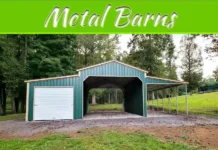A roof serves multiple functions beyond protecting against rainfall. The roof functions as an essential element to maintain house temperature comfort in hot, humid weather conditions. The selection of improper roofing materials leads to heat retention, which increases energy expenses while creating conditions for mold development. The selection of appropriate roofing materials produces significant differences in performance.
Best Roofing Materials For Hot, Humid Climates
Metal Roofing
Areas with intense heat and humidity benefit most from metal roofs as their selection. These materials reflect sunlight to maintain lower indoor temperatures. The material enables better ventilation that stops moisture from accumulating.
Another advantage is durability. Metal roofing stands up against mold and mildew growth, which typically occurs in humid environments. A metal roof maintained properly will survive decades without showing signs of warping or cracking.
Clay Or Terracotta Tiles
Clay tiles have been used in warm climates for centuries. They naturally resist heat and allow for good ventilation. The curved shape helps air circulate, reducing the amount of heat trapped inside. These tiles are also resistant to moisture, which helps prevent mold growth. While they can be heavy and require a strong roofing structure, their longevity makes them a smart investment.
Slate Roofing
Slate is a natural stone that offers exceptional durability and heat resistance. It stays cool under the sun and does not absorb moisture. This makes it a great option for humid climates where mold and algae are common problems. While slate roofs can be expensive, they can last for over a century with proper care. The classic look of slate also adds to the curb appeal of any home.
Asphalt Shingles With Cool Roof Technology
Traditional asphalt shingles tend to absorb heat, making them a poor choice for hot climates. However, modern versions with cool roof technology are now available. These shingles are designed to reflect sunlight and reduce heat absorption. They are also treated to resist algae growth, which is a common problem in humid regions. This option provides a balance between affordability and efficiency.
Proper Ventilation And Insulation
Choosing the right roofing material is important, but proper ventilation and insulation are just as crucial. A roof that does not allow heat to escape will trap warm air inside, making the home uncomfortable.
A well-ventilated roof allows air to circulate freely. Ridge vents, soffit vents, and attic fans can help regulate temperatures and keep moisture levels under control. Insulation also plays a major role in keeping a home cool. Reflective insulation materials prevent heat from penetrating the house. Spray foam insulation can also help seal gaps and prevent warm air from getting inside.
Roof Coatings For Extra Protection
Roof coatings add another layer of protection against heat and humidity. Reflective coatings help bounce sunlight away, reducing indoor temperatures. Some coatings also provide waterproofing benefits, preventing leaks and moisture buildup. Elastomeric coatings, for example, expand and contract with temperature changes. This helps prevent cracks and leaks over time. These coatings can be applied to metal, tile, or asphalt roofs for better performance in extreme weather conditions.
The Importance Of Regular Maintenance
Even the best roofing material will not last without proper care. Hot and humid conditions can cause wear and tear over time. Regular inspections help catch problems before they become serious.
Clearing debris from gutters and downspouts prevents water buildup, which can lead to mold and rot. Checking for loose or damaged shingles ensures the roof stays in good condition. Cleaning algae and moss growth also prevents long-term damage.
For those in the locality, hiring professional services like Austin Roofers can ensure proper maintenance and repairs when needed. Local experts understand the unique challenges posed by the climate and can recommend the best solutions.
Energy-Efficient Roofing Options
Energy-efficient roofing can help homeowners save on cooling costs. Some materials are designed to reflect heat, while others provide better insulation. Solar reflective shingles, for example, help reduce indoor temperatures. Cool metal roofing, white TPO membranes, and green roofs also provide energy savings. Investing in energy-efficient materials not only lowers bills but also reduces the strain on air conditioning systems.
Conclusion
For homeowners in hot, humid climates, choosing a roof that reflects heat and resists moisture is essential. Whether it is metal, clay, slate, or cool shingles, the right choice can make a significant difference in comfort and energy savings. With proper maintenance and the right materials, a home can stay cool and protected for years to come.





